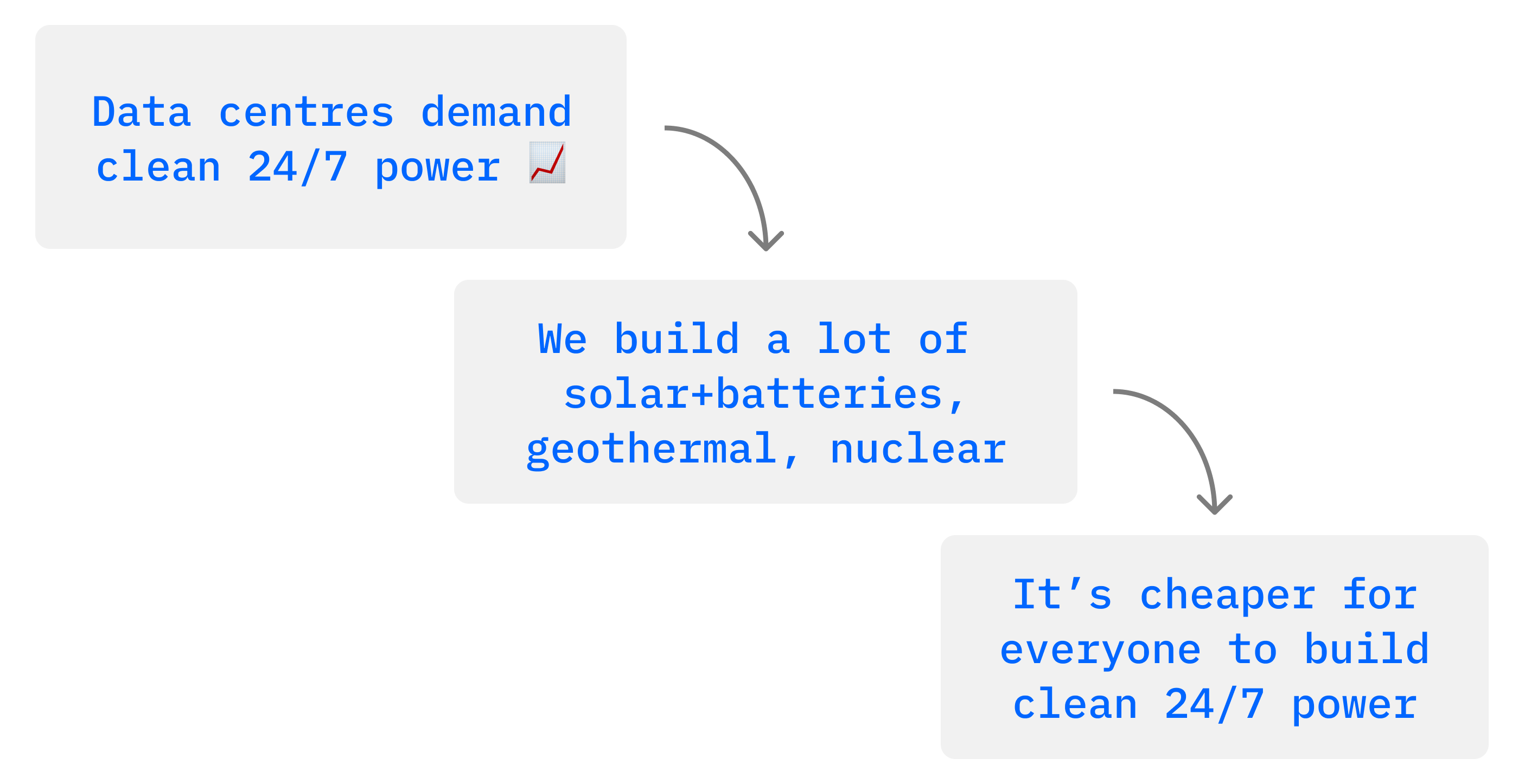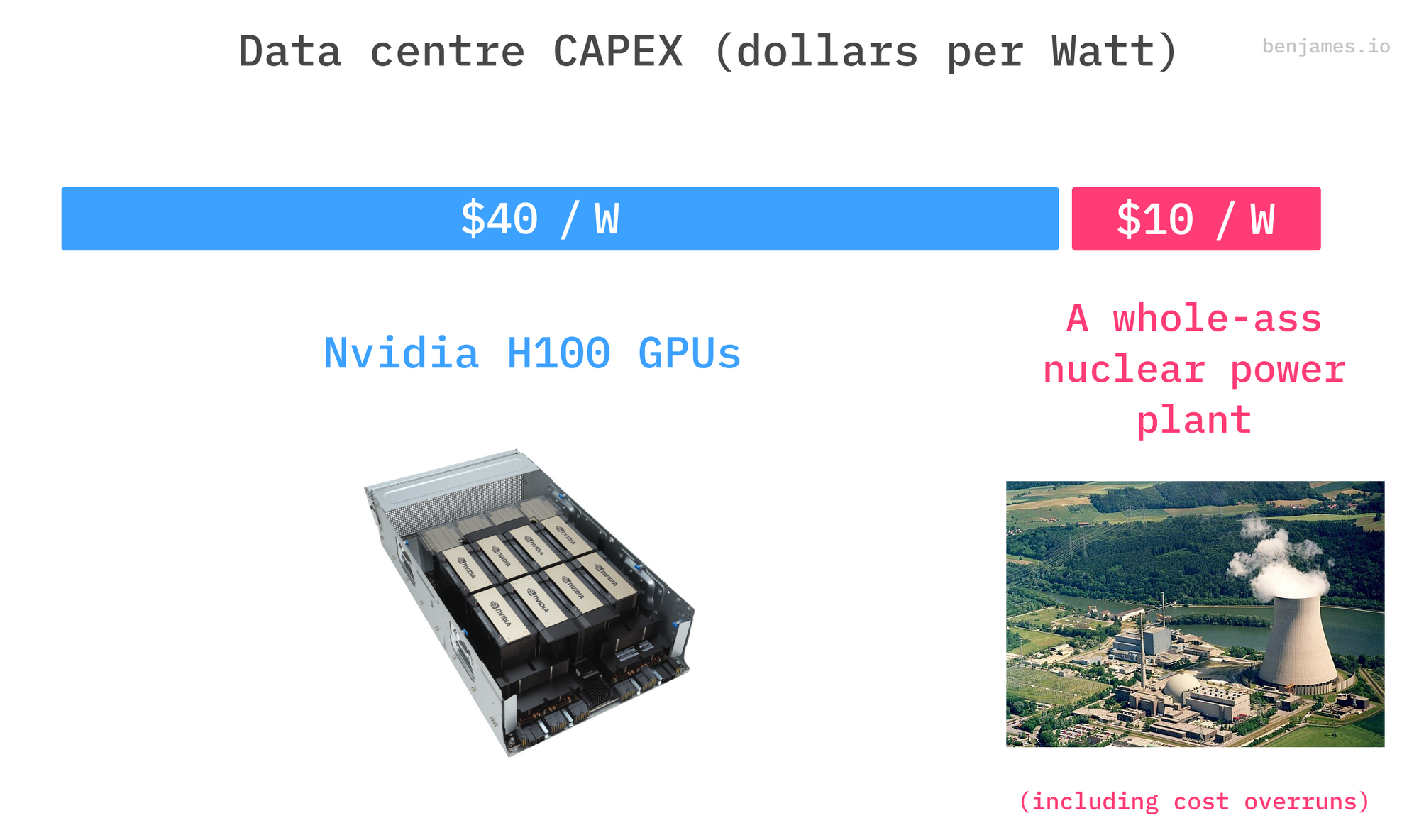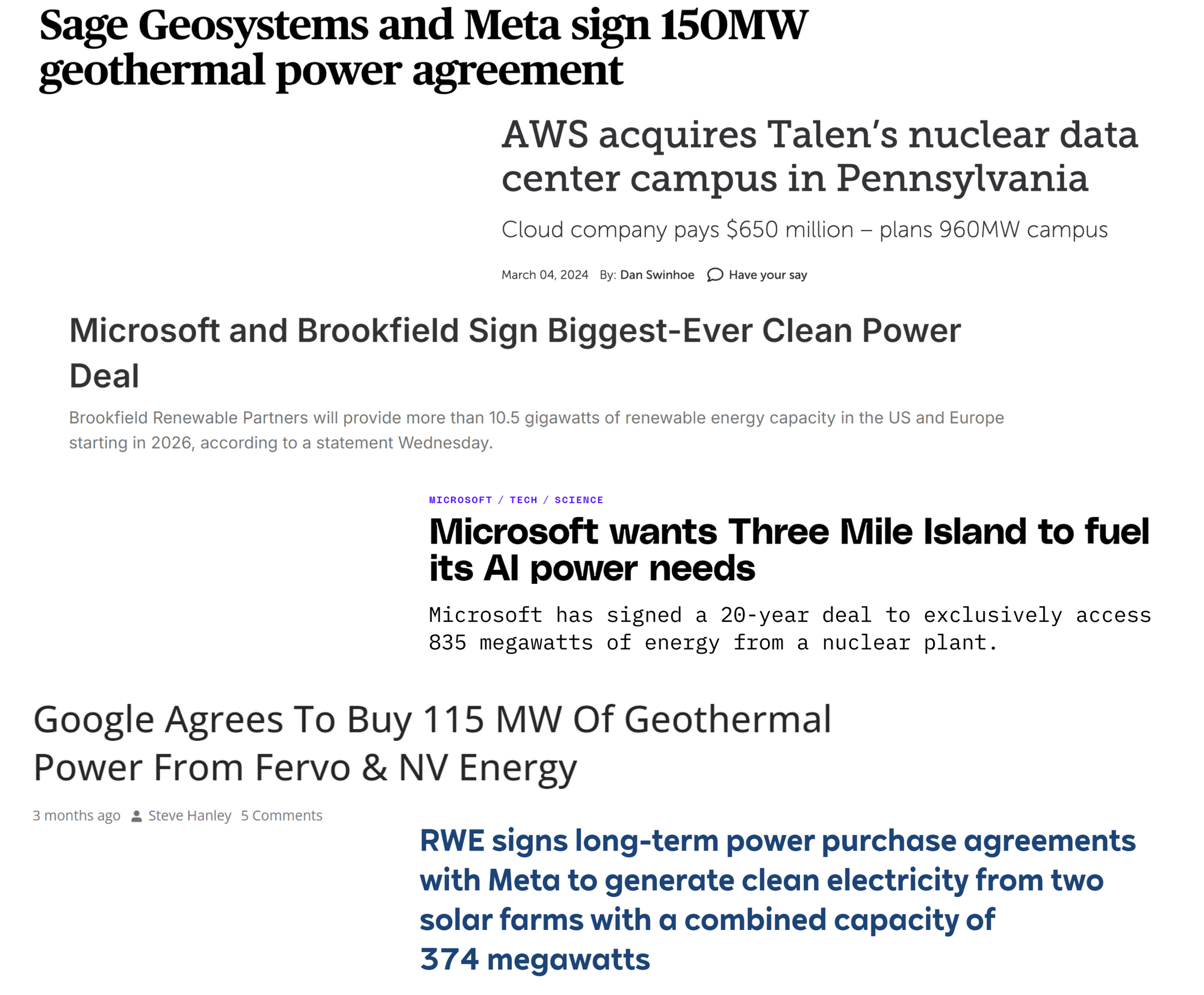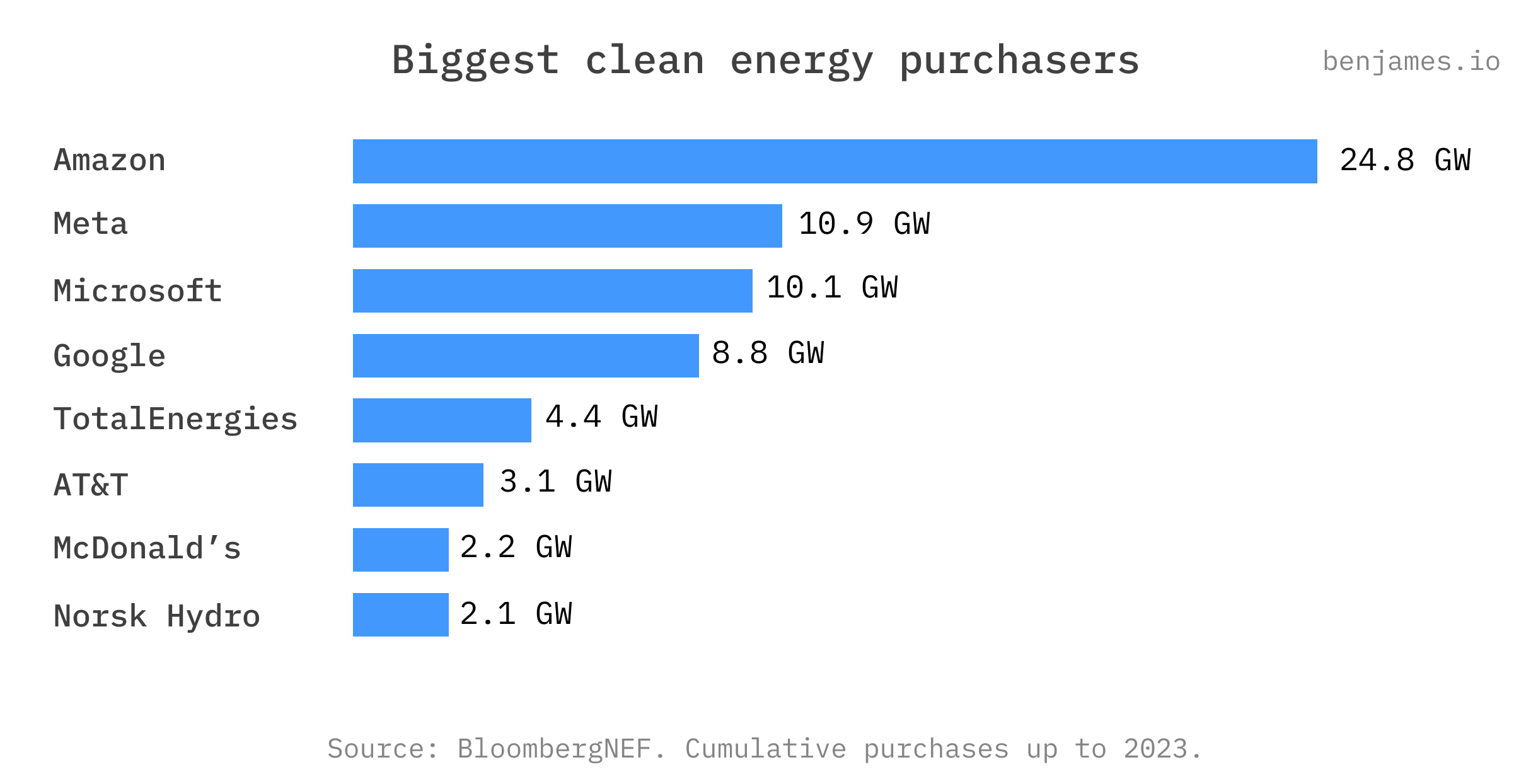AI will use a lot of energy. That could be good for the climate.
If you asked me how to scale clean energy, I would prescribe a magical source of urgent energy demand.
Someone willing to pay a premium to build solar+batteries, geothermal, and nuclear, in order to bring them down the cost curve and make them cheaper for everyone.
That is exactly what AI data centres are.
For the first time ever, securing clean 24/7 power is an urgent strategic priority for the most powerful organisations in the world:
- Tech giants, who have made strong commitments to using clean energy, and are willing to pay through the nose for it
- Governments who are determined to win the AI race. The only people who can fix the thicket of regulatory barriers to building energy projects quickly.
Many are worried that AI will increase emissions. This is true in the short term - emissions will rise for a few years. But it misses the bigger picture.

Clean energy technologies are famous for their learning rates - they get cheaper as you build more of them [footnote 1]. Data centres create price-insensitive clean power demand that will foot the bill of expensive early projects.
The perfect customer
Tech companies have the highest revenue per tonnes of CO2 emitted of any type of company. They are extremely cash-rich, and they are willing to pay extra for clean energy.
Tech giants upend the energy industry in four big ways:
1. Energy generation is the cheap part of an AI data centre.
Modern GPUs are pricey as heck. Eight Nvidia H100s in a single DGX box will run you $250,000.
Relative to compute, energy generation is cheap.

AI turns the electricity sector on its head. It places a premium on speed and low emissions, rather than cost.
Of course, tech companies will not wait a decade to build a nuclear plant before switching on their data centre. More on that later.
2. Urgency
The stakes could not be higher for big tech companies. If you are Google, you face the loss of your entire business within the next thousand days. Winning the AI race supersedes all previous priorities.
And let’s be clear, we will need a lot of power. A single H100 GPU uses the same electricity as two UK households. Meta is installing hundreds of thousands per month. Previously, data centres were chip-constrained, but now GPU production is ramping up. We are becoming energy-constrained. You don’t have to take my word for it - just follow the contracts.

3. Risk appetite
Traditionally, energy generation is financed by utilities, banks, and infrastructure funds. They build low-risk projects, with mature technology.
Tech companies are a bit more fun. They will yolo $hundreds-of-millions into fusion projects, linear generators, or whatever zany tech they like. They need power tomorrow, but they’re also willing to make big-if-true long term bets.
I don’t know if small nuclear reactors and advanced geothermal will ever get cost-competitive for widespread adoption. But I do know that until this year, they’ve never had such a well-suited customer.
There’s ideology here too. Tech companies are… techno-optimist. They exert their agency on the world, and they will attempt to venmo new technologies into existence. Sometimes this doesn't work, but sometimes it does.
They’ve made purchases from 43 carbon removal companies to date, and have advanced the field of Real and Actually Cool carbon removal immeasurably. Without Stripe, scientific and technological progress in carbon removal would be years behind what it is today.
4. Tech companies will become their own utilities.
Getting a new connection to the power grid takes years, often decades. Tech giants cannot wait that long.
In the short term, data centres will hoover up grid connections where they already exist. They will re-start Three Mile Island, or buy a bitcoin farm and convert it. If it is more profitable to use the grid connection of an aluminium smelter for AI, the aluminium smelter will die.
But existing grid connections are limited. In the medium term, tech companies will become their own utilities. They will build their own off-grid electricity generation at the sites of their data centres. This also saves money; about half the cost of energy is transporting it through the grid.
This is great news for solar and batteries, which can be thrown up in a field/desert in months instead of years.
AI training clusters are also much more locationally flexible than traditional servers, because they don’t need low-latency internet. Running a fibre line to the desert is a fraction of the cost of a data centre.
The president called, he likes your data centre.
The US and China will prioritise frontier AI development, because it will define the economic and military superpowers of the 21st century. (It is yet to be determined whether Europe will do the same.)
Governments haven’t yet realised what prioritising AI entails, but it will quickly become clear that it means making it easy to build new energy projects.
This is important because nuclear and geothermal are both bottlenecked by a labyrinth of permitting, land rights, and regulatory approval. For decades, western governments have had no urgent motivation to streamline these processes - until now.
There are a lot of barriers to scaling clean power that can only be addressed by policy. AI could be the decisive factor that spurs governments into action.
Will AI really only use clean power?
No. In the short term we will burn more gas to meet extra demand. This year, both Microsoft and Google announced that their emissions had spiked, driven mostly by AI energy requirements that materialised out of nowhere.
Currently, tech companies’ clean energy supply lags their demand. But they are serious about their climate commitments, and they are training their cash bazookas on the problem. As a reminder, tech companies remain the biggest corporate buyers of renewable power in the world. Google, Microsoft and Meta have all committed to carbon neutrality by 2030 - and they plan to get there.

It is clear that tech companies will not sacrifice speed, but they will sacrifice cost - as demonstrated by the steady stream of clean energy purchase announcements. You do not pay to restart the Three Mile Island nuclear plant as a cost-effective way to source energy.
Microsoft will pay $16 billion (!), just to extend the life of one nuclear reactor from 40 years to 60 years. Roughly $800m per year, for 20 years. (h/t Mark Nelson)
Tech giants take this extraordinarily seriously.
Even if their clean energy supply lags their demand temporarily, tech firms will pay to match their demand with clean generation purchases (often at an hourly level). That means that they have to purchase a lot of future clean energy contracts. Buying these contracts means that they pay to build new clean generation - whether directly or indirectly.
Not AI or climate - both.
It might seem naïve to think that AI and climate are complementary. But money has already started pouring into clean-firm power as a direct consequence of LLMs. Data centres will make clean energy cheaper just by building more of it.
There’s also the application of AI to climate solutions, which could be far more consequential than data centre energy use. That’s another blog post, but AI’s impact on science will undoubtedly be profound - from foundational chemistry and biotech, to materials discovery and catalysis. We stand at the brink of science 2.0, and it would be remarkable if this does not positively impact the energy industry within the next ten years.
One way or another, hundreds of millions of GPUs will crackle with the world’s data. Vast pools of capital will be brought to bear on the creation of thinking machines, and the opportunity for the energy industry is immense.
Done correctly, AI data centres will accelerate the economic and technological frontiers of clean-firm power. They have already started.
Thanks to Steve Newman, Rosie Campbell, William Bubenicek, and Rob Tracinski for their thoughtful comments on this piece. All opinions are mine, not theirs. Also, a shoutout to Nan Ransohoff for the original tweet that inspired this blog:
IMO an under-discussed thing about AI is its ability to actually be a huge accelerant towards a world with carbon-free energy ‘too cheap to meter.’
— Nan Ransohoff (@nanransohoff) May 2, 2024
The fact that the companies who need massive amts of net new energy *are also* the ones who have the ability to pay a premium for…
Follow me on Twitter/X, and read my other writings:
- The Big Guide to Batteries
- The Big Guide to Sustainable Aviation Fuel
- Actually, We Can Deploy Energy Infrastructure Very Quickly
Footnotes
Footnote 1
It’s still not clear how cheap nuclear fission will get as we build more of it. But it is true that all the cheapest nuclear plants in the world have been built as part of standardised, mass rollouts.
Small Modular Reactors have had little success so far, but they are only just encountering their dream customer: the AI data centre. If they are ever going to work, now is their chance.